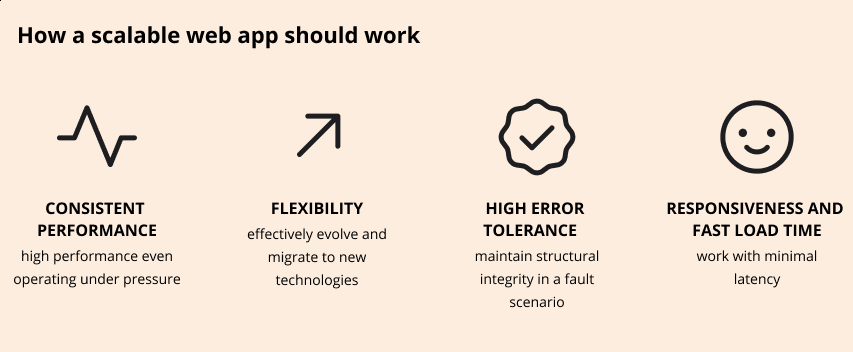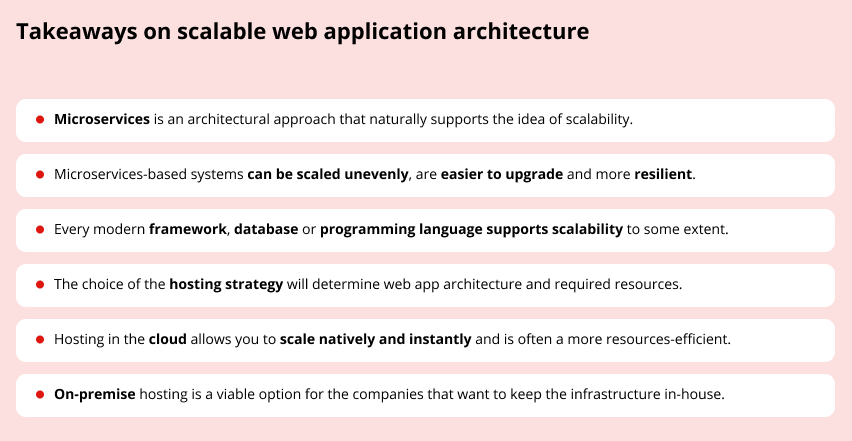How to Build Scalable Web Applications: Tips for Business
Scalability is an essential parameter to consider if you want to future-proof your web system. Many brilliant software products went into oblivion simply because they couldn’t manage the load or keep up with a fast-changing market.
In this article, we talk about the importance of scalability for business, describe the role of scalability in software architecture and development, and give a few tips on how to build scalable web applications effectively.
Scalability is a parameter that shows if a system is resilient to change. Normally, by change, we mean an increasing load, a growing number of users, data, added components and services. A scalable web application can handle such changes without compromising its performance and integrity.
In other words, no matter what you throw at them — an abnormal influx of user requests, surge in data flow or expanding functionality — scalable applications must cope.
Why should businesses care? Scalability is an important variable for any system that is supposed to expand at some point. From a business standpoint, a scalable system won’t crash during a seasonal traffic leap and won’t fail a sales campaign. Clients won’t drop off and switch to competitors because of slow and glitchy UI. And things won’t get weird when new features are developed and deployed.
How do you know if your product or solution needs to be scalable? Ask yourself:
- Will my system’s user base grow over time, and if yes, can this growth be predicted, controlled or capped?
- Will it have to deal with increasing traffic and load?
- Do I plan to scale to new geo or audience, expand services, products, business applications?
- Will I have to add more processing power to handle an ever-increasing amount of data?
- Do I need to integrate with 3rd party systems?
- Is high performance critical for my system?
- Will I scale my tech stack and adopt new technologies over time?
Understandably, the majority of modern web systems have to be designed and built with scalability in mind to evolve and compete. Knowing this, companies of all sizes from two-person startups to large firms emphasize the importance of building scalable web applications even before they start building their software.
However, this approach requires resources and comes at a cost. Therefore, it’s essential to understand what to scale, when, and how. And this is what we are going to talk about in the next parts of this post.
Before we get to the tips on how to build a scalable website or a web app, let’s first describe how a scalable system should work and perform.

Consistent performance
A scalable web application shows consistently high performance even operating under pressure such as a peak load or an unusual number of simultaneous requests.
Flexibility
Today’s technologies are constantly being replaced by newer, better and faster technologies of tomorrow. Scalable web applications are designed to embrace continuous change. They are able to effectively evolve, migrate to new technologies and adopt new services without wrecking the core.
High error tolerance
No system is fully immune from errors. A scalable system is not the one that is fault-free but the one that will maintain structural integrity and data safety in a fault scenario. Moreover, it should be able to quickly trace the problem and recover.
Looking for an experienced team to outsource web portal development and help you design, build and support a scalable web application? Check our web app development services and let’s talk!
How can we help you?
Responsiveness and fast load time
User-facing applications should work with minimal latency. It’s important to note that applications may have different requirements and user expectations when it comes to loading time and responsiveness. For example, a high-load web application for photo and image editing has a much lower tolerance to latency compared to an in-house B2E portal that employees will use either way.
These are some of the main, but by no means all characteristics that define a scalable application. In fact, scalability will be interpreted differently in each particular case depending on the types of growth and challenges systems have to withstand.
Now let’s talk about the main architectural principles that help create scalable web applications.
Architecture describes the structure of your system and interaction between its components — databases, services, client applications, hardware. Designing scalable web applications primarily starts with defining the style and principles of system architecture. The architect’s goal, in this case, is to build a flexible web application architecture that would meet current project requirements and, at the same time, have the capacity to scale up in the future.
Microservices vs. monolith
Microservices is an architectural approach that naturally supports the idea of scalability. It refers to building software out of a range of functional mostly independent components that communicate with each other using protocols. Each component can have its own tech stack and, importantly, scales unevenly depending on the current requirements and stage of development.
In practice, you can pour extra resources into particular parts of the system when they need it and build it up heterogeneously. On the contrary, a traditional monolithic architecture allows to scale a system only as a whole, which is often inefficient and way more expensive.
Microservices development works great for scalable web application architecture also because such systems are easier to upgrade to new technologies and by default are more resilient. Since every component is isolated, overload on one end won’t cause the whole system to collapse and may have little to no effect on other components.

Tech stack
Every modern framework, database or programming language today supports scalability to some extent. This is a huge value proposition, and providers make sure to evolve in this direction.
Generally, technologies today are much more resourceful than let’s say ten years ago. You can implement nearly any functional requirement with various technologies and the difference in performance won’t be significant.
Therefore, the choice of tech stack for building a web system won’t make a considerable impact on its ability to scale, assuming that we talk about modern technologies, of course.
The choice of the hosting strategy, on the other hand, will make a major difference. It will determine not only scalable web app architecture but also the resources needed to develop and support the system.
Cloud vs. on-premises hosting
Hosting refers to computing resources and services used to run your application and manage data. You can host your application on-premises — use your hardware and infrastructure and have a team of specialists to support it in-house. Or you can use public cloud services and devolve a hefty part of maintenance and support on a cloud provider. Importantly, your scale-up strategy will depend on the type of hosting you use.
Scalable web applications are often associated with the cloud. This technology is the key driver and enabler of scalability. Hosting in the cloud allows you to scale natively and instantly.
Cloud platforms, such as Amazon Web Services, Microsoft Azure and Google Cloud Platform, offer dozens of essential and simply useful services for effective data management, integration and infrastructure maintenance. It is often a more resource and time-efficient strategy. On the other hand, cloud hosting can also be more expensive than an on-premises approach.
On-premises scaling implies physical expansion of in-house computing power. It’s a challenging engineering task that requires not only resources but also skills and competence to install, administer and maintain a growing infrastructure. Moreover, the speed of on-premises scaling is limited by your ability to physically expand your infrastructure.
Associated cost and risks
The choice of hosting depends on a particulate business case. For example, a small startup will benefit from using cloud pay-as-you-go services and even free-tier offers instead of buying hardware and hiring admins to look after it.
As the system and load grow, so does the recurring cost of using cloud services. There is often a breaking point when many companies consider moving their infrastructure and scaling on-premises. In some cases, the reason for this shift is not only the cost but also the need to keep full control over the infrastructure in-house and enable better security.
In the next part of the post we will talk more about cost control over the scaling web system and give a few tips on how to make a scalable web application, so stay tuned.

Evaluate priorities and resources
Your approach to scalability will depend on your project requirements, resources and priorities. Just because you can make every single part of an application hyper scalable doesn’t mean you should. It will cost a fortune, let alone the effort and time you will have to invest into implementing your strategy.
On the contrary, it makes sense to first determine what parts of your application will have to bear the load and what has the potential to grow. Then you can decide on how to better allocate resources.
For example, if you are thinking about how to build a scalable web application that could serve millions of users monthly, start with identifying the services and features that would be used most frequently. When you are building an application for an IoT system, you should consider that it may grow from several nodes to hundreds or even thousands. It will result in an exponentially increasing amount of data, and then “you’re gonna need a bigger boat.”
Use proven techniques and engineering practices
The use of modern engineering practices, methods and techniques is vital in achieving and supporting scalability.
Some techniques help decrease the load on the database and increase overall backend performance (e.g. caching and load balancing for fast response; indexing, replication, mirroring to enable concurrency). Others focus on the speed and responsiveness of client applications (e.g. CDN and modern JavaScript libraries and frameworks to improve frontend performance). And there’s a whole category of DevOps practices and tools that not only drive efficiency to the development and deployment processes but also help deliver a more stable and reliable system (e.g. CI/CD pipelines, IaC, test and deployment automation).
That being said, these and many other methods and practices are commonly employed in microservices-based software development and are considered to be the best practices.
Monitor, measure and test performance
Stable performance defines scalability. It requires continuous monitoring, control and regular testing to make sure the system can handle what is coming.
Engineers set up different analytics and visualization tools to get a comprehensive view of system current and historic performance. Most cloud platforms provide toolkits for performance visibility and control. Aside from that, there’s a variety of performance analytics (New Relic) and data visualization platforms (Kibana, Grafana) that help developers monitor and control the performance of their systems.
Performance and stress testing are important to understand the limits of your system and gain foresight for future actions. Test your system regularly to see if you are reaching the tipping point and need to add resources, to trace issues and make timely steps to prevent them.

Use cost optimization tools
We have already mentioned that cost is often a deciding factor in choosing the hosting strategy and, therefore, the ability to effectively scale up. Many companies that opt for the cloud due to its flexibility, functionality and pricing, end up paying a lot more than they expected. In most cases, the reason is they pay for the services they don’t use.
This is why it is essential to have a cloud strategy and engage cost analysis tools. DevOps team should continuously monitor how the system is using resources to identify gaps and provide recommendations on how to optimize the cost.
Consider context for geo scalability
Scaling to new geo often depends on the context and specifics of a web application.
For instance, an all-online web platform for social media will work more or less the same way in any location, so its capacity to scale will be limited only by resources and time. Web applications that connect to local physical infrastructure (e.g. a retail platform connected to logistics and distribution operations) may require additional changes, integrations and entirely new features to scale to new markets.
And in some cases, geo scalability is extremely complicated or even impossible due to unique legal, policy and regulatory frameworks that exist in different countries.
In other words, to better understand how to make web applications scalable to new geo, you need to first analyze the context, dependencies and limitations of the new markets.
Technology consulting case study: Helping a global consumer insight company improve scalability capacity and develop a strategy to scale their Azure-based platform to the Chinese market.

At Digiteum, we have solid experience working with large-scale web applications and rapidly-growing startup projects. Our teams work on scalable web projects for our clients in the U.S., Europe, Australia and Canada. Here are just a few examples:
- We have built and now support and improve a custom performance monitoring and analytics system for one of the largest photo labs in the U.S. Thanks to this system, the client can monitor and control system performance and operations in real-time and make data-driven decisions on how to maintain sustainably high performance and improve scalability.
- Digiteum has been providing .NET development services and working on a high-load web application for photo printing services and products for over a decade. Over these years, the system has grown dramatically in volume and complexity, integrated with dozens of 3rd-party services, increased user base, and went through a few major migration projects. The system successfully sustains 200-300% seasonal load increases and shows excellent performance every year.
- A team of about 20 engineers including full-stack and data engineers, DevOps and QA specialists on our side is currently working on a highly scalable web network solution for precision medicine for a UK client. This system leverages dozens of AWS services, has a complex infrastructure and works with an increasing volume of data.
We have rich in-house competence in complex web system design and development and experience in working with all major cloud platforms. If you are looking for a team that not only knows how to build highly scalable web applications and but also has hands-on experience in designing and developing rich user interfaces with React.js app development services and Angular development services, you are just in the right place. Send your request via our simple contact form and tell us about your project.
How can we help you?
Summary
In this article, we covered a few key facts about scalability and gave our recommendations on how to design scalable web applications and build an efficient scalability strategy. If you need practical advice on a particular business case and need an expert opinion on how to improve the scalability of your web system, contact our team.
FAQ
- Choose a microservices approach to create flexible and resilient architecture.
- Consider hosting strategy depending on your resources, requirements and scalability speed.
- Use modern tech stack and adopt engineering techniques and best practices focused on supporting scalability.
- Use analytics and visualization tools to monitor, measure and test performance.
- Assign priorities to understand where and when to allocate resources.







